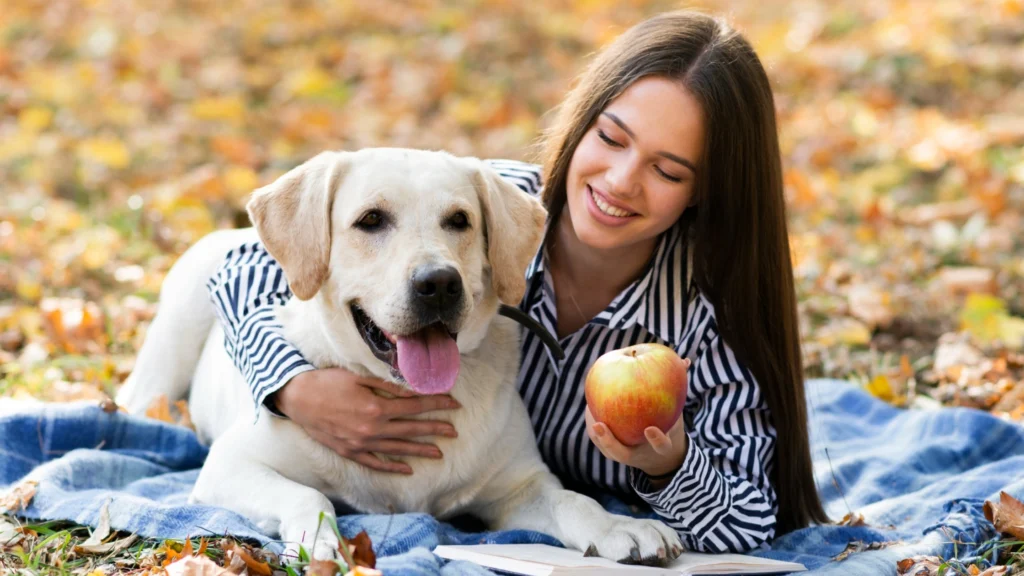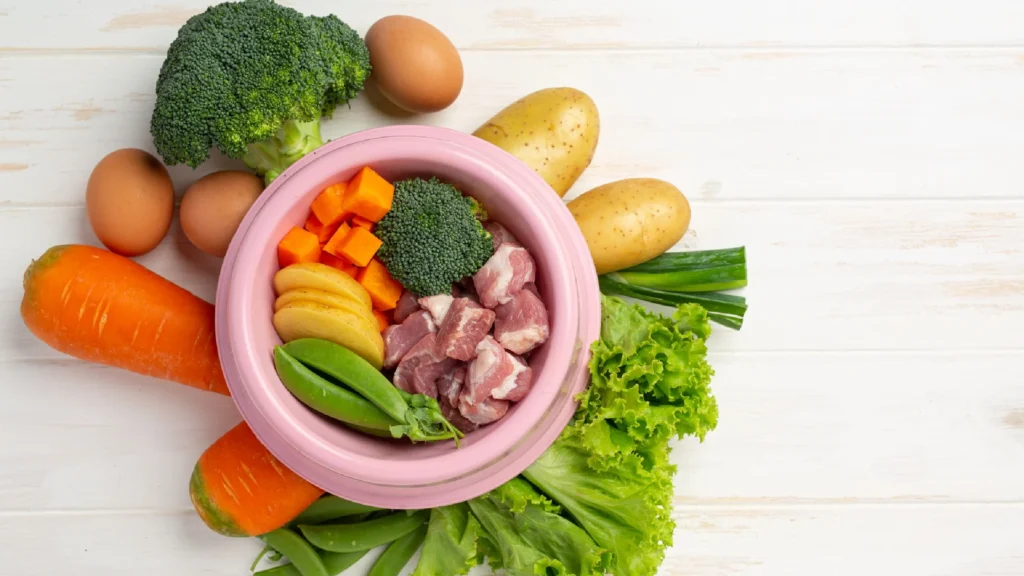
Introduction
When it comes to our furry friends, we often find ourselves questioning what foods are safe for them to eat. One common inquiry that arises is whether dogs can enjoy the sweet and juicy goodness of apples. In this article, we will delve into the topic and explore the truth behind the question: Can dogs eat apples?
Apples are a popular fruit among humans, known for their nutritional benefits and delicious taste. Naturally, dog owners may wonder if they can extend this treat to their canine companions. However, ensuring the safety and suitability of a particular food for dogs requires careful consideration.
In the following sections, we will navigate through the nutritional aspects, potential risks, and proper precautions associated with dogs eating apples. We’ll explore the benefits that apples offer to dogs, the potential hazards to be aware of, and how to prepare and serve apples to ensure the well-being of our four-legged friends.
Understanding whether dogs can safely consume apples will not only satisfy our curiosity but also empower us to make informed decisions about their diet. So, let’s embark on this journey to unveil the truth behind dogs and apples, ensuring the health and happiness of our beloved furry companions.
Nutritional Benefits of Apples for Dogs
Apples are not only delicious but also packed with essential nutrients that can benefit dogs in various ways. Let’s explore the nutritional benefits that apples offer to our canine friends:
- Vitamins: Apples are a rich source of vitamins, including vitamin A, vitamin C, and vitamin E. These vitamins play a vital role in supporting a dog’s immune system, promoting healthy skin and coat, and aiding in overall growth and development.
- Fiber: Apples contain a significant amount of dietary fiber, which can have several positive effects on a dog’s digestive system. Fiber helps regulate bowel movements, promotes healthy digestion, and can be beneficial for dogs with gastrointestinal issues.
- Antioxidants: Apples contain antioxidants such as flavonoids and polyphenols. These antioxidants help combat the harmful effects of free radicals in a dog’s body, reducing the risk of chronic diseases and supporting overall cellular health.
- Hydration: Apples have a high water content, which can contribute to maintaining proper hydration levels in dogs. Staying hydrated is crucial for optimal organ function, joint health, and overall well-being.
- Low in Fat and Calories: Apples are relatively low in fat and calories, making them a suitable snack option for dogs, especially those on a weight management program. They can provide a satisfying crunch and a burst of flavor without adding excessive calories to a dog’s diet.
It’s important to note that while apples offer several nutritional benefits, they should not replace a well-balanced and complete diet specifically formulated for dogs. Apples can be included as a healthy addition or occasional treat in conjunction with a nutritionally balanced dog food.
By incorporating apples into your dog’s diet, you can provide them with a range of nutrients that support their overall health and well-being. However, it’s essential to consider the proper portion sizes and take into account any individual dietary restrictions or sensitivities your dog may have.
Potential Risks and Precautions
While apples can be a healthy addition to a dog’s diet, there are some considerations and precautions to keep in mind. Let’s explore the potential risks associated with dogs eating apples and the necessary precautions to ensure their safety:
- Choking Hazards: Apples, especially when served in large chunks or with the core intact, can pose a choking risk for dogs. To prevent choking, always slice apples into small, bite-sized pieces that are easy for your dog to chew and swallow. Remove the core and seeds, as they can be hazardous if ingested.
- Apple Seeds: Apple seeds contain a compound called amygdalin, which can release cyanide when chewed or broken down. While a small number of apple seeds is unlikely to cause harm, it’s best to remove all seeds before offering apples to your dog. Avoid giving your dog access to apple cores or allowing them to chew on apple seeds.
- Moderation is Key: Like any treat or snack, apples should be given to dogs in moderation. While they offer nutritional benefits, excessive consumption can lead to an upset stomach, diarrhea, or an imbalance in the dog’s diet. Introduce apples gradually into your dog’s diet and monitor their response. Pay attention to any signs of digestive discomfort or allergic reactions.
- Individual Sensitivities and Allergies: Just like humans, dogs can have individual sensitivities or allergies to certain foods, including apples. Monitor your dog closely after introducing apples for the first time. Watch for any signs of allergic reactions, such as itching, swelling, or gastrointestinal disturbances. If you notice any adverse reactions, discontinue feeding apples and consult your veterinarian.
- Consider the Whole Diet: While apples offer nutritional benefits, they should be viewed as a supplemental treat rather than a primary source of nutrition. Ensure your dog’s diet consists of a balanced and complete dog food that meets their specific nutritional needs. Consult with your veterinarian to determine the appropriate diet and portion sizes for your dog.
By understanding the potential risks and taking necessary precautions, you can safely incorporate apples into your dog’s diet. Slicing apples into smaller pieces, removing seeds and cores, and practicing moderation are key to mitigating any potential hazards and ensuring your dog’s well-being when enjoying this canine-friendly snack.
Preparing Apples for Dogs
Before sharing apples with your furry friend, it’s important to prepare them properly to ensure safety and suitability. Here are some guidelines for preparing apples for dogs:
- Wash Thoroughly: Rinse the apple under cool running water to remove any dirt, pesticides, or residues that may be present on the skin. This step is essential to protect your dog from ingesting any harmful substances.
- Remove Core and Seeds: Apple cores and seeds can be hazardous to dogs. They contain small amounts of cyanide-releasing compounds, which can be harmful if ingested. Use a knife or an apple corer to remove the core completely, ensuring no seeds or stem remain.
- Slice into Bite-Sized Pieces: After removing the core, slice the apple into small, bite-sized pieces. This makes it easier for your dog to chew and swallow safely. Avoid giving your dog large chunks or whole apples, as they can pose a choking risk.
- Consider Your Dog’s Size: Adjust the size of the apple pieces based on the size of your dog. Smaller breeds may require smaller slices, while larger dogs can handle slightly larger pieces. It’s always better to err on the side of caution and provide smaller portions to minimize choking hazards.
- Serving Suggestions: You can serve the apple slices as they are or incorporate them into your dog’s regular meals or treats. Some dog owners choose to mix small apple pieces with their dog’s food or use them as a healthy training reward. Remember to keep the overall amount of apple given to your dog within moderation.
- Freeze for a Cooling Treat: On hot days, consider freezing apple slices for a refreshing treat. Dogs often enjoy the cold and crunchy texture, especially during warmer months. Frozen apple slices can provide a soothing sensation and help keep your dog hydrated.
Always monitor your dog while they are eating apples or any other food. Observe their chewing and swallowing patterns to ensure they can comfortably consume the slices. If you notice any signs of difficulty or discomfort, consider adjusting the size of the apple pieces accordingly.
By following these preparation guidelines, you can safely introduce apples into your dog’s diet. Remember to remove the core and seeds, slice the apples into suitable portions, and take your dog’s size and preferences into account. With proper preparation, you can offer your furry friend a delicious and nutritious apple snack.
Signs of Allergic Reactions or Digestive Issues
While apples are generally safe for dogs, individual dogs may have sensitivities or allergies to certain foods, including apples. It’s important to be aware of the signs of allergic reactions or digestive issues when introducing apples to your dog’s diet. Here are some common signs to watch out for:
- Itching and Skin Irritation: Dogs with apple allergies may experience itching, redness, or skin irritation after consuming apples. Keep an eye on your dog’s skin and coat for any signs of increased scratching, rashes, or hives.
- Swelling: Allergic reactions can sometimes manifest as swelling, particularly around the face, muzzle, or ears. If you notice any unusual swelling after your dog has eaten apples, it may indicate an allergic response that requires attention.
- Gastrointestinal Disturbances: Digestive issues can occur when dogs consume apples, especially if they eat too much or have a sensitive stomach. Watch for symptoms such as diarrhea, vomiting, excessive gas, or abdominal discomfort. These signs may suggest that apples are not well-tolerated by your dog’s digestive system.
- Changes in Behavior or Energy Levels: In some cases, dogs may exhibit changes in behavior or energy levels as a result of an adverse reaction to apples. They may appear lethargic, unusually restless, or display signs of discomfort. Monitor your dog’s overall demeanor and note any significant changes.
If you observe any of these signs or suspect that your dog may be experiencing an allergic reaction or digestive issues related to apples, it’s important to consult your veterinarian. They can provide a proper diagnosis, determine the cause of the symptoms, and advise you on the best course of action.
It’s worth noting that allergic reactions can vary in severity. In severe cases, dogs may exhibit difficulty breathing, facial swelling, or collapse, which requires immediate veterinary attention. If you observe any severe symptoms, contact your veterinarian or an emergency veterinary clinic right away.
By paying close attention to your dog’s response to apples and being vigilant for any signs of allergic reactions or digestive issues, you can ensure their well-being and address any concerns promptly. Not all dogs will experience such reactions, but it’s crucial to be prepared and responsive to any potential issues that may arise.
Healthy Alternatives and Treat Recipes
While apples can be a tasty and nutritious treat for dogs, it’s always good to have some alternative options to provide variety in their diet. Here are a few healthy alternatives to apples and some simple treat recipes you can try:
Alternative Fruits:
a. Blueberries: Packed with antioxidants and low in calories, blueberries make a great alternative to apples. They can be served fresh or frozen.
b. Watermelon: A hydrating and refreshing fruit, watermelon is safe for dogs when served in moderation. Remove the seeds and rind before offering it to your dog.
c. Bananas: Rich in potassium and fiber, bananas are an easily digestible fruit that many dogs enjoy. Slice them into small pieces or mash them for a tasty treat.
Vegetable Snacks:
a. Carrots: Crunchy and low in calories, carrots are an excellent source of vitamins and minerals. Serve them raw or lightly steamed for a satisfying chew.
b. Cucumber: Refreshing and hydrating, cucumbers can be sliced into bite-sized pieces for a cool snack option.
c. Green Beans: Cooked green beans make a nutritious and low-calorie treat for dogs. They can be served plain or frozen for a crunchy texture.
Homemade Treat Recipes:
a. Frozen Apple Bites:
Ingredients: Apples, plain yogurt (unsweetened and without additives)
Instructions: Slice apples into small pieces, remove core and seeds. Dip the apple slices into yogurt and place them on a baking sheet. Freeze until firm. Serve as a refreshing treat.
b. Banana-Oat Cookies:
Ingredients: Ripe bananas, oats, peanut butter (without xylitol)
Instructions: Mash the bananas and mix them with oats and a spoonful of peanut butter. Shape the mixture into small cookies and place them on a baking sheet. Bake at a low temperature until they are lightly golden. Allow them to cool before serving.
Remember, when introducing new treats or recipes, start with small portions to ensure your dog tolerates them well. Monitor their response and make adjustments as needed based on their individual preferences and dietary requirements.
It’s always a good idea to consult with your veterinarian before making any significant changes to your dog’s diet or introducing new treats. They can provide personalized guidance based on your dog’s specific needs and health considerations.
By offering healthy alternatives and exploring homemade treat recipes, you can provide your dog with a variety of tasty and nutritious options beyond apples, while still prioritizing their well-being and dietary requirements.
Conclusion
In conclusion, the question of whether dogs can eat apples has been unveiled, shedding light on the nutritional benefits, potential risks, and proper precautions associated with this popular canine snack. Apples offer vitamins, fiber, antioxidants, and hydration, making them a healthy addition to a dog’s diet when prepared and served appropriately.
However, it’s crucial to be aware of the potential choking hazards, the toxicity of apple seeds, and the importance of moderation. By slicing apples into bite-sized pieces, removing the core and seeds, and practicing portion control, you can mitigate these risks and ensure your dog’s safety.
Additionally, it’s essential to monitor your dog for any signs of allergic reactions or digestive issues when introducing apples or any new food. Every dog is unique, and some may have sensitivities or allergies to certain ingredients. If any adverse reactions occur, consult with your veterinarian for guidance.
To provide variety in your dog’s diet, there are alternative fruits and vegetable snacks you can consider, such as blueberries, watermelon, carrots, or green beans. Homemade treat recipes, like frozen apple bites or banana-oat cookies, offer healthy and delicious options beyond plain apples.
Remember, while treats like apples can be enjoyable, they should not replace a balanced and complete diet specifically formulated for dogs. Always prioritize your dog’s overall nutrition and consult with your veterinarian for guidance on their specific dietary needs.
By making informed decisions and considering the nutritional benefits, potential risks, and individual sensitivities, you can incorporate apples into your dog’s diet safely and provide them with a variety of healthy and delicious treats. Your furry companion will appreciate the occasional apple indulgence while staying happy, healthy, and well-nourished.
Read More
- The Ultimate Guide: Unveiling the Best Ingredients for a Healthy and Happy Dog
- 5 Dog Food Ingredients to Avoid for a Healthy Canine Diet




